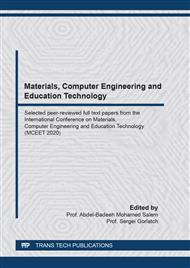p.3
p.8
p.17
p.25
p.42
p.48
p.59
p.68
p.79
Fabrication of Chemically Linked PEGylated Prodrugs for Hydrogel Carriers
Abstract:
Some hydrophilic drugs (e.g. anti-tumor drug of doxorubicin (DOX) and anti-osteoporosis drug of alendronate sodium (ALN)) have great toxic and adverse effects on the human body. In this paper, two kinds of drug-loaded composite gel systems were prepared via mild and efficient chemical reaction synthesis, hyaluronic acid-linked ALN (HA-ALN) hydrogel and polyethylene glycol-linked DOX (Tetra-PEG-DOX) hydrogel. By characterizing their chemical structures, morphological networks, and ultraviolet absorption behaviors, two different types of drug-loaded composite gels can be constructed well. It is expected to achieve effective drug loading and controlled release. The two drug-loaded gels are applied in the fields of antitumor and anti-osteoporosis and exert their application value in the field of biomedicine.
Info:
Periodical:
Pages:
42-47
Citation:
Online since:
April 2021
Authors:
Price:
Сopyright:
© 2021 Trans Tech Publications Ltd. All Rights Reserved
Share:
Citation:


